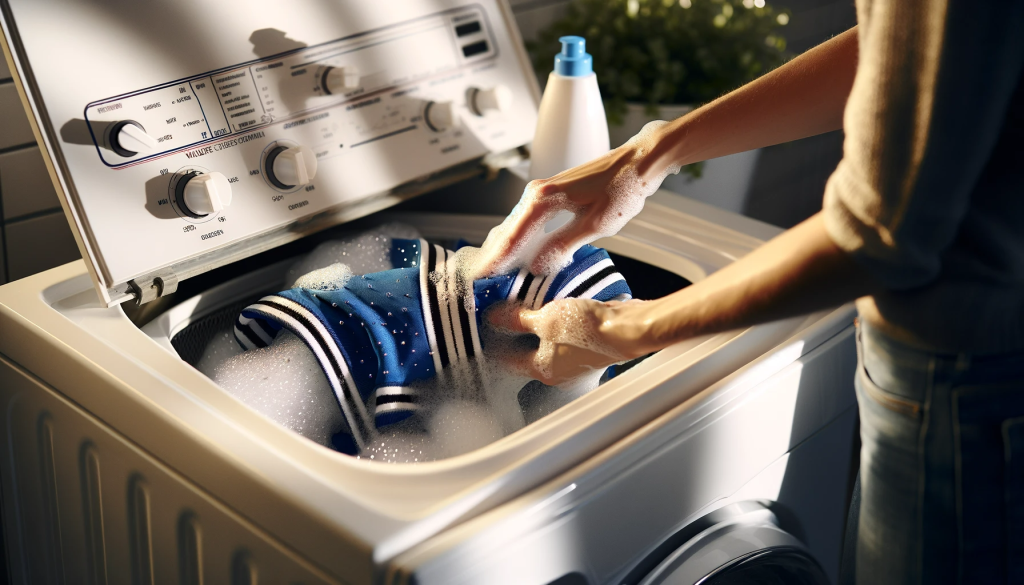Struggling with wardrobes that cling tighter than ever? Dive into solutions that promise a carefree flair with every wear, blending practicality with style—just the way you like it. For more apparel inspiration that keeps you both comfortable and chic, visit inktasticmerch.com to explore a captivating range of options!
Fed up with clothes behaving like they’re glued together as soon as they come out of the dryer? You’re not the only one—static cling is a common nuisance, particularly during arid seasons.
This article provides expert advice and strategies to liberate your wardrobe from static electricity’s clutches. Continue reading to transform your clingy outfits into comfy attire!
Key Takeaways
- Static cling arises from static electricity buildup, typically due to friction between garments and dry skin or diverse fabrics in the dryer.
- Fabric softeners and dryer sheets alleviate static cling by coating fibers, diminishing electrical charges, and balancing ions.
- For natural prevention, enhance indoor humidity using a humidifier or houseplants, separate natural and synthetic materials during washing and drying, utilize vinegar as a natural softener, and keep your skin hydrated.
- Quick fixes for tackling static on the go include antistatic sprays, gently rubbing clothes with metal to distribute charges, or lightly spritzing hairspray on problem areas.
- Long-term strategies to eliminate static include reducing dryer times and using dryer balls for agitation, air-drying garments outdoors, applying fabric conditioners, moisturizing skin, and choosing apparel made from natural fibers.
Understanding Static Cling
Understanding Static Cling: Exploring the intricacies of static cling uncovers that it isn’t simply about clothing sticking together; it’s rooted in fundamental scientific principles.
Amid various myths, we’ll debunk misconceptions and elucidate the true reasons your garments become magnets for unwanted attraction.
What Causes Static Cling
Static cling surprises when dry skin and clothing ignite sparks. As you don your favorite sweater or enjoy those snug pajamas, friction occurs. This interaction generates static electricity, making garments cling together as though held by an invisible magnet.
Many may be unaware of the triboelectric effect, where different materials contact to produce electrical charges. Imagine synthetic fabrics twirling in the dryer’s heat; they unconsciously accumulate an electrostatic charge with each tumble.
This accumulation transforms your laundry into a stage for static-laden clothing antics.
Common Myths About Static Cling
It’s commonly thought that certain fabrics are more susceptible to static cling, but this isn’t true. The electrostatic charge, not the fabric characteristics, causes those pesky shocks and clinging garments.
Another common misconception is that dryer sheets add moisture to reduce static electrical buildup. In fact, they work by coating fibers with substances that decrease electrical charges.
Some believe that repeated material friction in a tumble dryer causes static; however, friction itself isn’t the main culprit. Humidity levels play a greater role than typically acknowledged—higher humidity levels can avert static cling since water conducts electricity and helps disperse electric buildups before they affect your clothing.
Additionally, moisturizing your skin might seem like a potent tactic against static for the clothes you wear, but it doesn’t tackle the root issue within the fabrics themselves.
Tips to Eliminate Static Cling

Wave goodbye to the nuisance of fabrics clinging and sparking with those surprising jolts; here’s a collection of expertly recommended tactics to rid your wardrobe of static cling. Explore these clever fixes to ensure your clothes move freely and comfortably, free from any electric nuisance.
Use Fabric Softeners When Washing Clothes
Fabric softeners are your ultimate companion in defeating static cling. Adding a dose to your laundry can work wonders, forming a slick coating on fabric fibers that not only boosts softness but also takes charge of static management, rendering each garment more wearable and easily manageable after washing.
This antistatic aid serves as a protective barrier during the wash cycles, minimizing friction and reducing the electric charge accumulation.
Enhance fabric care by incorporating this softness booster during the rinse cycle; it’s a straightforward step for softer strands and significantly fewer creases. Treating clothes with a fabric conditioner allows you to step out looking polished and relieved from static’s pesky grasp – an effortless solution for a daily annoyance that transforms your daily wardrobe experience.
Utilize Dryer Sheets
Dryer sheets are akin to a magic charm for your laundry, swiftly eliminating static cling issues. Simply place one in the dryer with your clothing, and it harmonizes the ion balance within the fabrics.
This nifty technique prevents shirts from sticking to skirts and socks from persistently attaching to pants. The positively charged ions in dryer sheets neutralize excess electrons, eliminating that bothersome zapping sensation when separating clothes.
Moreover, they’re versatile; rub a dryer sheet along the inner side of an outfit to address any unexpected static. It acts as an antistatic buffer, ensuring a smooth day with no unwanted clothing attachment. Frequent use guarantees each garment emerges soft and free of cling, demonstrating your mastery over static electricity without complicating your laundry routine.
Keep Your Clothes Moist
Sustaining a slight moisture level in your clothes can revolutionize your fight against static cling. Much like dryer sheets, this method diminishes the buildup of electrical charges.
An easy approach involves placing a small, damp washcloth in the dryer alongside your laundry. The moisture from the washcloth works wonders, keeping everything supple without any stiffness or unwanted clinging.
Alternatively, vinegar serves as a natural fabric softener while combating static electricity. Introduce a vinegar-dampened cloth into the dryer for an eco-conscious and effective way to maintain your clothes’ moisture.
This strategy nullifies static accumulation, making your garments feel rejuvenated while avoiding harsh chemicals typical of conventional softeners. Implement these tips on your next laundry day to shed the stress of clinging attire!
Increase Home Humidity
Enhancing your home’s humidity is crucial in battling static cling. Dry air is a breeding ground for static electricity, causing clothes to cling together and deliver tiny shocks. Using a humidifier to consistently add moisture to your indoor air can drastically reduce the electrostatic charges accumulated on fabrics.
Houseplants are not only decorative but also practical; they naturally humidify as they release moisture.water vapor during transpiration subtly boosts humidity levels in a room.
By ensuring consistent moisture through plant upkeep or utilizing a humidifier, you can enhance indoor air quality and keep your wardrobe free of static cling.
Separate Natural and Synthetic Fabrics
Balancing home humidity is key to reducing static, but another helpful tactic is sorting laundry by fabric types before washing and drying. Mixing natural fibers like cotton, wool, and linen with synthetics like polyester and rayon can create the perfect conditions for static electricity to accumulate.
The differing attributes of these materials lead them to rub together, generating electrical charges that cause clothes to cling together or stick to your skin.
To avoid this issue, categorize your clothing into two groups—naturals and synthetics—before beginning your laundry cycle. This strategy will decrease friction among various fabric types as they tumble in both the washer and dryer.
If you lack sufficient garments for a full load, consider employing mesh laundry bags to keep items separated in the machine. Remember, hang drying on a clothesline sidesteps all that tumbling, conserving energy and helping prevent static-induced clinging.
Quick Fixes for Static Cling

Is static cling catching you off guard with no time to employ laundry solutions? Don’t worry—we have some swift strategies to tame static, ensuring your clothes cooperate before you step out.
Use a Static Reducing Spray
Contending with clothes sticking together or to your skin can be a nuisance. Grab a bottle of static-reducing spray, like Sprayway Anti-Static Spray, and watch that concern disappear in seconds.
These sprays are specifically formulated to address the pesky issue of electrostatic discharge by neutralizing the charges that make fabrics stick.
For a quick solution, spray a light mist over your outfit before wearing it or even after you’re dressed. You’ll find this handy remedy at many drugstores; it’s a fast and efficient way to ease static troubles.
Spraying your clothes can quickly transform any clingy outfit into one that’s comfortable and smooth, giving you one less worry in your day. Keep a travel-sized static guard in your purse or car for those unexpected times when static makes an appearance!
Rub Clothing with Metal
Reach for a metal hanger or any metallic item nearby; it’s time to eliminate that pesky static cling. Slowly glide the metal over your garment where it’s clinging, and witness how this straightforward trick dissipates the electrical charge causing the problem.
Metals possess conductive properties that neutralize static electricity, providing an immediate solution without special tools.
Feel free to utilize common items like a spoon or even aluminum foil in a bind. The essential aspect is establishing contact between the fabric and metal, enabling electron transfer and balance.
This approach is especially handy when you’re away from home or in need of an instant fix before heading out. Remember, gentle rubbing is key—being too forceful might damage delicate fabric!
Run a Hanger or Aluminum Foil Along Clothes
In continuation of the metallic approach, another
A simple technique to tackle static cling involves common household items. Slide a metal hanger over your clothes to neutralize the pesky static charge. The metal works to disperse and eliminate the built-up static electricity.
Alternatively, aluminum foil is more than just a kitchen staple! Shape a piece of foil into a ball and toss it in with your laundry in the dryer. This unexpectedly effective solution allows the foil to absorb electrical charges as your clothes tumble, keeping your wardrobe cling-free without any fuss.
Utilizing aluminum foil this way reduces the likelihood of static shocks when folding and managing your freshly laundered clothes.
Moisturize Your Skin
Combat static cling by moisturizing your skin. Applying lotion boosts surface humidity, forming an invisible barrier that prevents clothes from adhering.
It’s a convenient fix you can employ anytime and anywhere. Plus, it keeps your skin soft and hydrated during those dry, static-prone months.
Select a moisturizer suitable for your skin type, preferably one without strong scents or additives that might stain clothing. After applying lotion, gently rub your hands over troublesome clothing to transfer moisture and swiftly eliminate static charge.
This natural remedy not only serves as a precaution but also acts as a quick solution to reduce fabric cling, ensuring static-free attire throughout the day.
Spritz Hairspray on Clothes
Spraying a little hairspray on your clothes can be a lifesaver when facing static cling. It’s especially useful when you’re out and about without access to dryer sheets. Simply shake an aerosol hairspray and lightly mist the areas where fabric sticks.
Be sure to spray from a distance to prevent wet spots or stains.
For garments that seem to hold static like a lightning rod—such as polyester dresses or skirts—hairspray is your best friend.
A brief mist between fabric layers can work wonders in taming those recalcitrant materials that cling at every step. Remember this trick when you need an instant antistatic solution without specialty products.
Preventing Static Cling

Going beyond quick fixes, preventing static cling involves adopting habits that keep your clothing free from static’s tight grasp. Explore methods to maintain the natural balance in your fabrics, transforming each laundry day into a journey toward sustained, static-free peace.
Decrease Dryer Time
Reducing dryer time is beneficial for multiple reasons. It helps deter static cling by preventing over-drying that can generate electric charges.
Additionally, shorter dryer durations conserve energy and protect your garments from excessive wear. To achieve this, add anti-static dryer balls to your dryer; they effectively separate clothes and enhance air circulation.
An alternative way to cut drying time is to remove garments while they’re still slightly damp—not drenched, but just shy of completely dry. This tactic also lessens wrinkles, saving ironing time!
After removing clothes from the dryer, give shirts and pants a swift shake before either hanging them up or laying them flat to finish drying naturally. This method helps prevent additional static buildup, which can occur if clothes are left in the machine for too long.
Using Dryer Balls
While reducing dryer time is an effective strategy, introducing dryer balls elevates static prevention to a new level. These handy tools work by bouncing around, creating separation between clothes for better airflow and minimizing fabric clinging.
Think of them as tiny garment masseuses, massaging your clothes to avoid static electricity. Opt for wool dryer balls, which are a natural choice that not only reduce static cling but also soften your laundry without the use of synthetic chemicals present in commercial softeners.
Their reusable nature makes them an eco-friendly option for maintaining your laundry. Even simple tennis balls can serve as a low-cost solution, ensuring each garment emerges from the dryer fresh and static-free.
Air Dry Clothes
Air drying clothes is a simple yet effective way to eliminate static cling. By avoiding the dryer and instead hanging your clothes on a line or drying rack, you bypass the tumbling and heat that often cause fabrics to become electrically charged.
This is particularly beneficial for synthetic fibers, which are more susceptible to static buildup. Air drying allows these materials to naturally discharge as they dry in the open air.
Opting for this method not only mitigates static but also prolongs the lifespan of your clothing by reducing the wear from a typical dryer cycle. For extra protection, use a fabric conditioner during washing; it adds an additional barrier against static before you even reach for the clothespins.
Be sure garments have enough space on the drying rack to allow moisture to evaporate efficiently, resulting in softer clothes with less static. Now that your laundry is static-free, consider how using fabric softener further mitigates this issue.
Use Fabric Softener
Incorporating fabric softener into your washing routine is like sending your clothes straight to a static-free zone. As it mingles with the water, this detergent companion envelops each fiber with a protective layer, reducing static and leaving your garments soft and smooth.
Consider it a gentle soothing agent that neutralizes bothersome electric charges formed during friction between fabrics. Your sweaters and tops will emerge from the wash ready to wear, devoid of cling or unexpected sparks.
For an environmentally friendly alternative, white vinegar can replace conventional fabric softeners, delivering static reduction minus the chemicals. Simply add it to the rinse cycle and behold its natural efficacy—your clothes will emerge gratitude-filled, free from shocks and wonderfully comfortable against your skin.
This straightforward shift maintains a static-free environment while indulging your wardrobe with the gentle care nature provides.
Line-Dry Clothing
Line-drying your clothes is an excellent method to avert static cling. This natural drying approach allows air to flow around fibers, lessening the friction that can lead to static electricity.
Synthetic fabrics, in particular, benefit from being hung outside, as they are more inclined to develop static. By opting to line-dry rather than using an electric dryer, you conserve energy and decrease the chances of clothes clinging together post-drying.
Drying garments in the open air offers additional advantages; sunlight imparts a natural bleaching effect.
Infuse your whites with brightness and combat bacteria effectively. Make sure clothes crafted from natural fibers have ample time to air out, as these materials retain moisture, aiding in the reduction of static build-up.
Managing laundry doesn’t need to rely on high-tech solutions—traditional techniques like using fabric softeners alongside air-drying can offer remarkable antistatic benefits while preserving the integrity of your garments.
Wear Moisturizer and Choose Natural Fabrics
Applying lotion to your skin before dressing can significantly prevent clothes from clinging. The lotion’s moisture acts as a shield against static electricity accumulation.
This effortless routine boosts skin moisture, forming a protective layer between you and your attire.
Prefer clothes made from natural fibers such as cotton or wool to further decrease static cling. These fabrics naturally lower fabric friction, allowing clothing to drape smoothly without sticking to your skin.
By moisturizing and selecting garments made from natural fibers, you ensure a day of comfort free from bothersome clinging clothes.
Conclusion
Bid farewell to the annoyance of static cling with confidence. Incorporate these expert tips into your laundry practices and enjoy the pleasure of static-free attire. Each suggestion is designed for simplicity and effectiveness, allowing you to easily overcome this everyday irritation.
Venture out with clothing that falls elegantly, unrestrained by static cling. Let’s make clingy socks and unexpected shocks a thing of the past!
FAQs
1. What’s a quick way to eliminate static cling in clothing?
To swiftly eliminate static cling, glide a metal hanger or dryer sheet over your garments.
2. Can humidity influence static cling in clothing?
Indeed, increased humidity can help diminish static cling in clothes.
3. Which fabric is less prone to developing static?
Natural fibers like cotton are typically less prone to static than synthetic materials.
4. Do certain laundry aids help prevent static cling?
Using fabric softeners or dryer sheets during the wash and dry cycle can aid in preventing static cling.
5. Can wearing different fabric layers reduce the chance of static?
Layering garments made from various fabric types can sometimes help lower the risk of static cling.
For more expert insights and practical advice on clothing care, be sure to check out our Blog. Discover a world of tips to enhance your wardrobe and style effortlessly.




